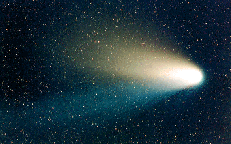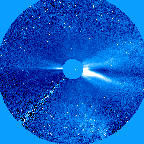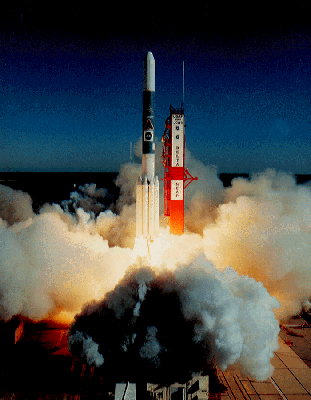
Glossary:
C and D
- Calorimeter
- An instrument for measuring quantities of heat
- Caltech
- The California Institute of Technology in Pasadena, California.
- Charge exchange
- The loss of an electron by an atomic particle to an ionized atom. This can occur when neutral interstellar material leaks into the heliosphere and runs into ionized
solar wind to create pick-up ions.
- Chromosphere
- The part of the Sun just above the photosphere. Thousands of miles thick, it is mostly hydrogen gas. It looks like a red ring during an eclipse. The corona is just above the chromosphere.
- Collimator
- A part of an instrument that selects the arrival direction of incoming particles or energy. Three collimators are in SEPICA, an instrument on the
ACE spacecraft.
- Comet
 A small body, of mostly ice and dust, in orbit around the Sun or passing through the solar system in large orbits. While passing near the Sun, the comet's vaporized ice becomes its two tails, a bright white one composed of dust, and a blue one made up of ionized gas.
A small body, of mostly ice and dust, in orbit around the Sun or passing through the solar system in large orbits. While passing near the Sun, the comet's vaporized ice becomes its two tails, a bright white one composed of dust, and a blue one made up of ionized gas.- Composition
- What an object is made of
- Corona
- The outer part of the Sun's "atmosphere". In the outer region of the corona, particles travel away from the Sun and stretch far out into space. The corona can only be seen during total solar eclipses, appearing as a halo around the moon.
- Coronagraph
 An
instrument that makes it possible to observe the corona at times other than during an eclipse. A simple lens focuses the
Sun onto a disk that blocks the light from the solar disk, providing
an artificial eclipse. This image of the Sun is from the SOHO/LASCO
coronagraph instrument.
An
instrument that makes it possible to observe the corona at times other than during an eclipse. A simple lens focuses the
Sun onto a disk that blocks the light from the solar disk, providing
an artificial eclipse. This image of the Sun is from the SOHO/LASCO
coronagraph instrument.- Coronal holes
- Large regions in the corona that are less dense and cooler than surrounding areas. There is a constant flow of low density
plasma escaping from the holes.
- Coronal mass ejections (CMEs)
- Huge bursts of solar wind rising above the Sun's corona. One of the biggest explosions in our
solar system.
- Corotating
- Sharing the rotation of a planetary magnetic field, as in
Corotating Interaction Regions.
- Corotating Interaction Regions (CIRs)
- The area in the heliosphere where there is an interaction between high and low speed streams of solar wind that causes a shock wave of high density, pressure and magnetic field strength.
- Cosmic rays
- A stream of particles that have been accelerated to almost the speed of light in space. Some enter the Earth's atmosphere and bombard atmospheric atoms.
C
D
- Data analysis
- Processing, checking over, and trying to understanding information (data).
- Delta II rocket

The Delta II is the latest generation of Delta medium-launch vehicle. It was used to launch the ACE spacecraft, among others.






Click on images above to
learn more about them
A service of the Heliophysics
Science Division at NASA's GSFC
Questions and comments to: cosmicopia@cosmicra.gsfc.nasa.gov
Curator: Dr Eric R. Christian, NASA
Responsible NASA Official: Dr Eric R. Christian
Privacy Policy and Important Notices
Questions and comments to: cosmicopia@cosmicra.gsfc.nasa.gov
Curator: Dr Eric R. Christian, NASA
Responsible NASA Official: Dr Eric R. Christian
Privacy Policy and Important Notices

HOME
In the News
History
Ask Us
Great Links
Glossary
Site Map
Search NASA